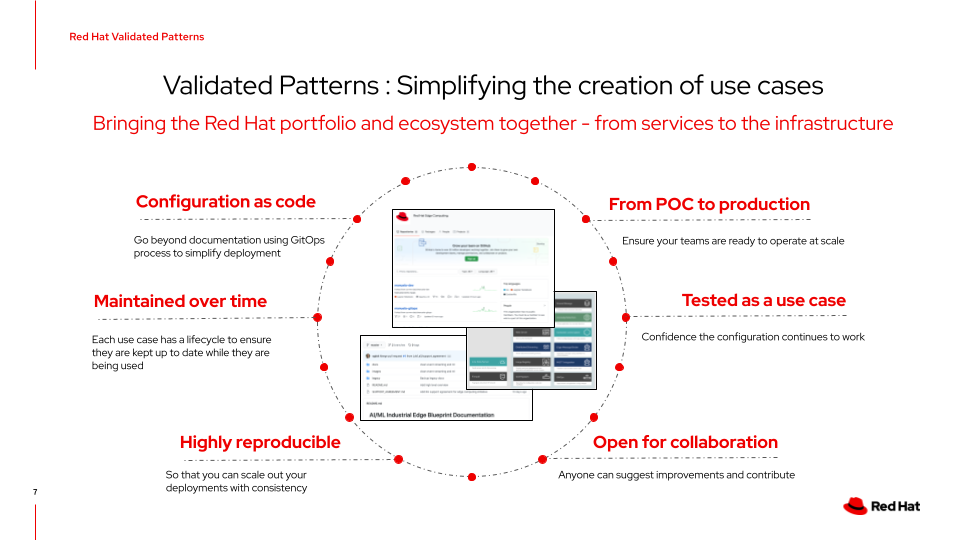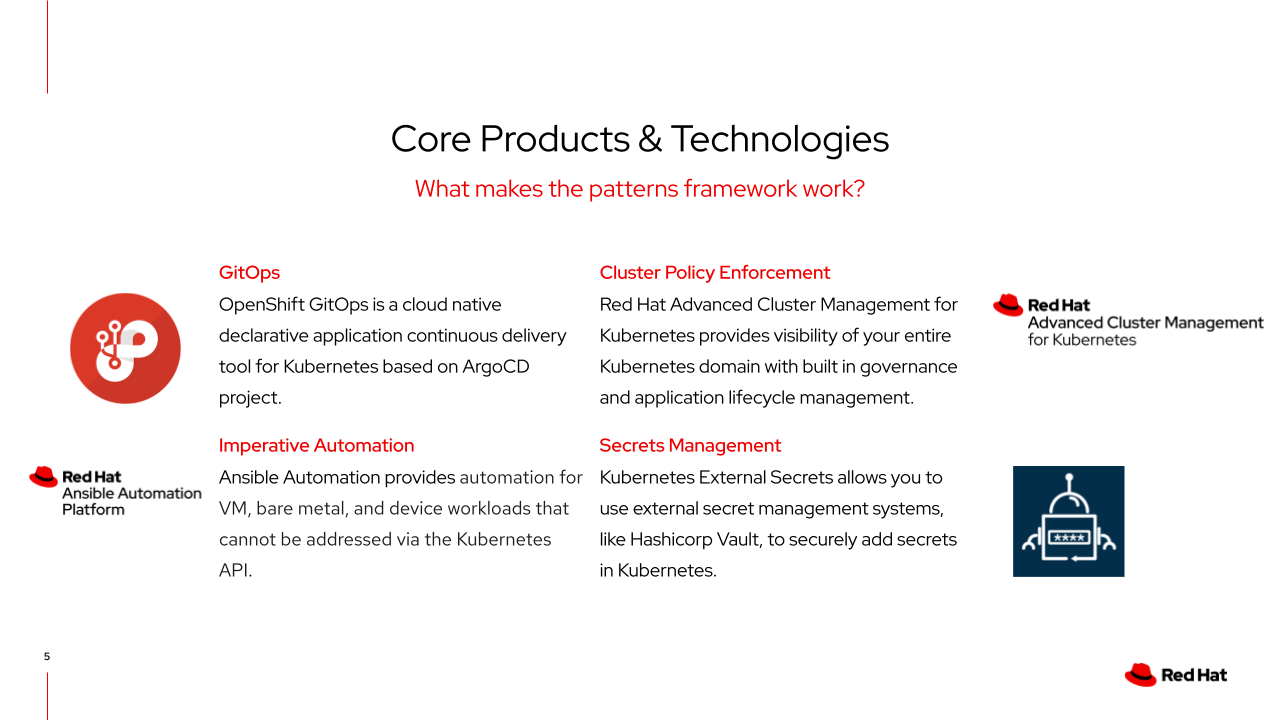Topic Objectives
In this topic we will discuss:
-
What is a Validated Pattern?
-
Explain high level benefits provided by Validated Patterns
-
Discuss what is included in the patterns initiative
-
Detail the difference between a community and validated patterns
-
-
Who are Validated Patterns for?
-
Explain the high level benefit for each persona
-
Clarify the requirements to become validated
-
-
Where can you keep up to date or point people to find more information?
What are Validated Patterns?
Validated Patterns are an evolution of reference architectures. Each pattern is given a lifecycle when it is added to Red Hat’s continuous integration (CI) system because we’re testing against the latest version of operators, OpenShift releases and across multiple public cloud environments.

Business Goals
Every organization is facing the need to transform itself into a digital business. It’s part of an evolution to help accelerate innovation by making application development faster - fueled with data insights, and enabled through technologies like containers, kubernetes and artificial intelligence/machine learning.
In order to be successful, they know they must also look at how to be more operationally agile and efficient in order to quickly meet business needs. Hybrid-Cloud computing coupled with these new technologies is helping create new opportunities to achieve these goals.
Validated Patterns are focused on customer solutions and Proof-Of-Concepts (POC’s).

Benefits
Red Hat’s validated patterns are a collection of repositories that show a customers use case in the form of Kubernetes Resources (helm charts, kustomize, primitive objects) that describe an hybrid cloud stack declaratively and comprehensively; from its services down to the supporting infrastructure. Validated Patterns facilitate complex, highly reproducible deployments and are ideal for operating these deployments at scale using GitOps operational practices.

-
Use a GitOps model to deliver the use case as code
-
Use as a POC, modified to fit a particular need that you can evolve into a real deployment.
-
Highly reproducible - great for operating at scale
-
Open for collaboration, so anyone can suggest improvements, contribute to them or use them as the Git Repositories are all upstream
-
Can be modified for customers needs. If you would like to swap out a component, use Ceph Storage instead of S3, it is as easy as commenting out sections and including other repos.
-
Tested. Once made a validated pattern, the use case is included into Red Hat’s CI and continues to be tested across product versions while the pattern remains active.
Batteries Included
Validated Patterns are a "batteries included" solution. This means that wherever you start with the patterns framework a core and configurable set of components are delivered out of the box.
Take a look at the following graphic - each Validated Pattern (use-case dependent) consumes these technologies. The modularity of the framework allows us to add/remove resources to meet the requirements of the use-case. If a pattern only deploys on a single cluster, there is no need to deploy Red Hat Advanced Cluster Management for Kubernetes, therefore we can remove the declarations for Red Hat Advanced Cluster Management for Kubernetes in the values-hub.yaml.

| Reusability is a major theme that will be seen throughout this workshop. |
When we dive into these core technologies we start to see the low-level technology being used throughout the framework

Who are patterns for?
Value provided by Validated Patterns is unique to each individual or organization. Generally speaking Patterns provide value to our:

-
Customers - get going faster, reduce risk, time to value
-
Sales - don’t spend time architecting, they have a tested use ccase for a base deployment. Though messaged for a specific vertical in some cases, they can be used across other verticals.
-
Partners - free use of a defined architecture that you can build a solution on top of. All the value to accelerate sales/deployments.
-
Can also be used as a way to promote your product (HashiCorp)
-
-
GSIs or Consulting Services - predefined architectures, ready to deploy with minimal modifications. They can trust in the use-case as it is maintained across production version updates.